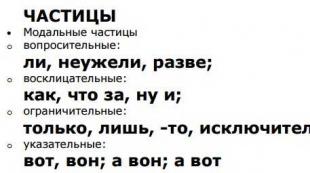Table on the theme of the particle. How to recognize a particle in a sentence. What particles help form the imperative and conditional moods
Instruction
If you need to learn how to find particles in the text, then first of all remember that this is a service part of speech. Therefore, you will not be able to put a question to this word, as, for example, to independent parts of speech (noun, verb, adverb, etc.).
Learn to distinguish the particle from other service parts of speech (prepositions, conjunctions). It is also impossible to put a question to them, as well as to particles. But conjunctions do a different job in a sentence. If prepositions connect words in syntactic constructions, and unions - or simple sentences as part of a complex one, then we need particles, for example, in order to form a mood in a verb.
Use the verb "to be friends" in the imperative and in the conditional. You need to use shape particles for this. So, the particles "would", "b" form the conditional mood "would be friends." But such particles as "let", "let", "yes", "come on", "let's" will help you express some kind of request or order, i.e. use a verb in the form: "let them be friends."
Keep in mind that particles are also necessary in order to express your thoughts: to clarify something, to express an affirmation or denial, to point out some detail, to soften the requirement, etc. For example, the particles "not" and "neither" will help you communicate the absence of something, the particles "only", "only" - to clarify something, etc. And in the sentence "Over there, beyond the mountains, the sun appeared," the particle "out" indicates action.
Learn to distinguish the particle "neither" from the repeated union "neither". For example, in the sentence "I can neither cry nor laugh," the words "no-no" are a repeated conjunction, because they connect homogeneous predicates. But in the sentence "Wherever he was, he found friends everywhere," the word "neither" is a particle, because. introduces an additional meaning (statement) into the given syntactic construction.
Learn to distinguish between the particle "that", which is necessary to soften the requirement, from suffixes in indefinite pronouns or adverbs. So, in the sentence "Did you manage to exercise?" the particle "that" helps to add an additional shade. But in the adverb "somewhere" or in the pronoun "someone", "that" is a suffix, with the help of which new words are formed from interrogative pronouns and adverbs. Remember that the particle "that" is written with a hyphen with nouns.
Be aware that particles are not members of a sentence, like all other auxiliary parts of speech. But in some cases, for example, when using a verb with particles "not", "would", "b", they will play a syntactic role simultaneously with the predicate.
Particle- this is a service part of speech, which serves to express shades of the meanings of words, phrases, sentences and to form word forms.
In accordance with this, particles are usually divided into two categories - modal (semantic) and shaping.
Particles do not change, are not members of the sentence.
In school grammar, however, it is customary to emphasize the negative particle not together with the word to which it refers; especially for verbs.
Toformative particles include particles that serve to form the forms of the conditional and imperative mood of the verb. These include the following: would (an indicator of the conditional mood),let, let, yes, come on (those) (indicators of the imperative mood). Unlike semantic particles, formative particles are components of the verb form and are part of the same member of the sentence as the verb, they are underlined with it even in a non-contact arrangement, for example: Iwould notlate, ifwouldnotwentrain.
Modal (semantic) particles express the semantic shades, feelings and attitudes of the speaker. According to the specific meaning they express, they are divided into the following groups:
1) negative: not, not at all, far from, not at all;
2) interrogative: really, really, whether (l);
3) index: here, out, this;
4) clarifying : exactly, just straight, exactly, exactly;
5) restrictive excretory: only, only, exclusively, almost, only;
6) exclamatory: what for, well, how;
7) amplifying: even, even, not, after all, after all, after all, well;
8) with the meaning of doubt : hardly; hardly.
In some studies, other groups of particles are also distinguished, since not all particles can be included in these groups (for example, they say, supposedly, they say).
Particle neither acts as a negative in the constructions of an impersonal sentence with an omitted predicate (In the room neither sound) and as amplifying in the presence of an already expressed negation (In the room not heard neither sound). When repeating a particle neither acts as a repeating coordinating union (You can’t hear in the room neither rustles, neither other sounds).
Modal (semantic) particle -then must be distinguished from the word-forming postfix -to, which acts as a means of forming indefinite pronouns and adverbs. Compare: some, somewhere (postfix) - I -then I know where to go (particle).
Postfixes -sya (-s), -to, -either, -nibud and prefixes not and neither in the composition of negative and indefinite pronouns and adverbs, as well as participles and adjectives, are not particles, regardless of continuous or separate spelling.
Morphological parsing of a particle
Particles are disassembled according to the following plan:
I. Part of speech. Grammatical role (for what it serves).
II. Morphological features: rank by value
According to school grammar, all particles, both semantic and formative, should be disassembled according to this scheme, however, it should be noted that the formative particle is a component of the verb form and is written out during morphological analysis together with the verb when parsing the verb as a part of speech.
Sample morphological parsing of a particle:
I do not claim that he did not suffer at all; I just became completely convinced now that he could go on about his Arabians as much as he liked, giving only the necessary explanations (F. M. Dostoevsky).
I. Non-particle
II. immutable, modal (semantic), negative.
I. only - particle
I. only - particle
II. immutable, modal (semantic), restrictive-excretory.
According to school grammar, in this sentence one should also parse the particle as follows:
I. would - particle
II. immutable, formative, serves to form the form of the conditional mood of the verb.
Particle- one of the official parts of speech. It brings additional shades of meaning to the sentence.into words, phrases and sentencesand can also form word forms.The main role of particles (general grammatical meaning) is to add additional shades to the meanings of other words, groups of words or sentences. Particles clarify, highlight, strengthen those words that are necessary for a more accurate expression of the content: « Already the sky breathed in autumn, Already the sun shone less.» ( Pushkin A.S.) Already is a particle with an amplifying value.
Particles arose later than other parts of speech. By origin, particles are associated with different parts of speech: with adverbs ( just, just, just, just, just and etc.); with verbs ( let, let, come on, give, it would, after all, you see and etc.); with unions (and, yes, and and etc.); with pronouns ( everything, it, what for, then, this, yourself etc.), with interjections ( out, well and etc.). Some particles are not related to other parts of speech in origin: here, is it and etc.

There are few particles in Russian. In terms of frequency of use, they are in the first hundred most used words (as well as prepositions, conjunctions and some pronouns). This hundred of the most frequent words includes 11 particles ( not, well, here, only, yet, already, well, not, even, whether, after all ).
In their structure and functions, the particles are close to adverbs, conjunctions and interjections.
Particles differ from significant parts of speech in that they do not have lexical meanings, therefore particles are not members of a sentence, but can be part of sentence members. Particles differ from prepositions and conjunctions in that they do not express grammatical relationships between words and sentences, i.e. the particle never binds anything.
When parsing the particle is singled out together with the word to which it refers or not singled out at all.
In the science of the Russian language, there is no consensus on the classification of particles. Different authors have different classifications.

Particles are divided into 3 categories - semantic, negative and shaping.
Shape-forming particles are let's, yes, let's, would, b, it happened, let, let. Unlike semantic particles, formative particles are part of the verb form and the same member of the sentence as the verb: I would not know if he had not told.
Particle- one of the official parts of speech. It introduces additional shades of meaning into the sentence, and can also form word forms.
Shaping particles: let, let, yes, let's - form an imperative form together with the verb, for example: let them run, let's put up, let there be peace.
Particle would forms the conditional mood of the verb: I would like, I would say, I would go.
Particles that introduce different semantic shades are divided into
affirmative(yes, yes, exactly, well, yes)
negative(no, no)
interrogative(really, is it, is it, or what),
comparative(like, as if, as if, exactly, as if, like, as if),
amplifying(even, still, after all, already, everything, after all, simply, directly),
index(out, this, here)
clarifying(precisely, exactly, exactly, exactly),
excretory-restrictive(only, only, at least, only, exclusively)
exclamatory(what for, then, how, well, after all),
expressing doubt(hardly, hardly).

The meaning and negative particles are presented below in the form of a table.
| Particles | Shades of meaning | Usage examples |
| not, not at all, not at all, not at all | negation | He far from as generous as it seems |
| really, is it, is it (l) | question | Really don't you notice it? |
| here, out, this | indication | Take here this book |
| exactly, just, exactly, exactly, exactly | clarification | He exactly the same like his grandfather |
| only, only, exclusively, almost, exclusively | restriction, selection | We only once seen him |
| what the, well, how | exclamatory | Well you have a big dog! |
| even, even, not, after all, after all, after all, well | gain | Even and don't think about it |
| hardly, hardly. | doubt | Hardly you can do it |
Particles must be distinguished from interjections Oh, uh, ah, oh etc., used to express an intensifying connotation, which (unlike interjections) are not separated by commas (and are not accented).
Creative work on the topic:
"Particles in Russian"
Performed:
7th grade student "A"
Balashova Svetlana
Morphological features
A particle is a service part of speech that serves to express various semantic shades of any member of a sentence or a sentence as a whole, as well as to form moods. The particle introduces additional semantic shades into the sentence and serves to form word forms. Invariable part of speech. The particle is not a member of the sentence.
Morphological features: shaping, negative, modal. Formatives serve to form the conditional and imperative mood of the verb. These include: yes, come on, let's, would (b), let, let. Negatives serve to express negation, reinforce negation, or give the sentence a positive meaning in case of double negation. These include: no, no. Modal are used to express various semantic shades and feelings in a sentence. These include: is it really, is it, what kind of, how, here, only, only, really, etc.
Modal particles contribute the following semantic shades:
1) question: is it, is it really, for example: Have you prepared the past material for today's lesson? Didn't you make the right choice by continuing your education?
2) indication: here, out, for example: Here are the necessary tools for a practical lesson;
3) clarification: exactly, just, for example: It is this specialist who will be in demand to work in our company;
4) allocation, restriction: only, only, exclusively, for example: Only those who passed will be allowed to take the exams. A medical worker should be an exceptionally kind, sympathetic, merciful person;
5) exclamation: what kind, how, for example: How nice it is for the teacher to see the success of his students!
6) doubt: hardly, hardly, for example: It is unlikely that you will cope with the task if you do not make efforts;
7) amplification: even, really, after all, after all, for example: How many times have the basic terms been repeated;
8) mitigation, requirement: - ka, for example: Repeat this topic again.
Particles are also a class of words expressing diverse relationships that are realized in an act of speech or text, namely: the relationship of the reported to the participants in the act of speech (speaking, listening), as well as the relationship between them; the attitude of the reported to reality (in terms of its reality, unreality; reliability, unreliability); relation between statements and their components. By expressing these relationships, the particles realize their meanings. In some meanings of the particle, semantic components are presented that modify the content of the message (only, everything, was, not, neither).
Particles, in addition, serve to form morphological and syntactic moods (if, let, let). In the Grammar of the Modern Russian Literary Language, particles are classified according to a different basis - according to functions. There are three main categories: syntactic (would, let, yes, come on, etc.), subjective-modal (after all, even, maybe, really, etc.) and negative (not, not) particles. Among subjective-modal particles, amplifying particles differ in meaning (something, even, after all, here, here), excretory (only, only), etc. In the Russian Grammar, the main categories of particles are also distinguished by functions. Characterizing a sign (action or state) according to its course in time, according to the completeness or incompleteness of implementation, according to the effectiveness or not effectiveness (it was, it happened, it happens, etc.). The particles in this grammar are also classified according to their structure: they are divided into primitive and non-primitive, into simple (and, fortunately, more, etc.) and composite; composite particles are divided into dissected (that would be, that's it, like this, etc.) and not dissected (would be good, if only, still, etc.); inside the compound particles, phraseological units are distinguished (no-no and; what of what, etc.). Thus, the question of the classes of particles and the principles of their selection is solved in different ways. In the study of particles as lexical units in their system, a large number of intersecting subclasses are found, interconnected by a variety of relationships.
Various classifications can be applied to particles as units of a language, taking a separate value of a particle as a classification unit (for example, in the classification proposed below). The most adequate to linguistic reality are those classifications that reflect the semantic properties of particles. However, the analysis of particle semantics is impossible without taking into account the specifics of their functioning. According to the main classification feature - semantic particles are divided into eleven categories. Modal particles expressing different types of subjective relations. With the help of such particles, the meanings associated with two types of modality are expressed: reality / unreality and certainty / unreliability.
With the meanings “possibility”, “desirability”, “necessity”, associated with the opposition reality / unreality, the particular meanings of expectation expressed by the particles (simply, and, precisely, nevertheless, nevertheless; for example, And you agreed!), surprises (well, look how), incentives, encouragement, demands, wishes (come on, well, so that, otherwise, would, let, if, when, it would be good; for example, I have to live!; To be good meeting!), reminders / reminders (tea, more, for example, Take a candy! - I don’t see sweets!; Remember her: she still sang a song for you!), assumptions (maybe, as if, exactly, as if, like , exactly, in no way; for example, if someone entered?), fears (unequally); with the opposition of reliability / unreliability, particular meanings of confirmation (yes, exactly), assumptions (let it be, well, good), doubts, distrust [yes, no, directly, unless, as if; e.g.: I will find you a book! -Yes, you can find it! (in the meaning of "you will not find"); I'll stay. No, really? (meaning "can't believe")]. Emotionally expressive particles expressing various emotional characteristics (threat, surprise, dissatisfaction, annoyance, irony, mockery): Well, you see, you see, simply, directly. These words (except simply, directly) are classified by some researchers as interjections as words that serve the sphere of emotions. They approach particles when they function as a modal component of a sentence.
Address particles expressing the semantics associated with the social sphere. This semantics can be reduced to the oppositions higher/lower/equal; own / someone else's. This category includes particles: -ka, -s (obsolete). In the values of the particle, a sign of categorical/non-categorical character is found, which leads to the sphere of modal values. Contextual particles that serve to identify the author's behavior, to draw attention to certain components of an utterance or text. Context particles are associated with the organization of speech activity (already, and, yes, no, here, out; for example, Yes, one more news; Yes, I almost forgot, you have a letter), with all sorts of clarifications regarding selected expressions, fillings "Emptiness" in speech (or that, namely), and with indications of the transfer of someone else's speech (they say, de, they say, supposedly). Quantitative particles expressing the quantitative characteristic of the component of the propositional content from the point of view of the speaker (only, only, just like that).
Negative particles specialized in expressing negation (no, no). Phase particle (was) that modifies the propositional semantics of the verbal predicate, expressing that the action began or was expected, but did not take place or was interrupted. Emitting particles expressing the meaning of inconsistency or correspondence of the supposed, expected and actual (only, only, even, already, exactly, and).
Identifying particles [same, and; for example, Here he was born, here he lives all his life; I have the same book (like the one in the window)], which serves to express anaphoric relations in the text (relationships of coreference or equal lexemes). Gradational particles expressing the growth of a feature (even). Particles-replicas and able to function in the dialogue as a replicating component (yes, okay, okay). The semantic classification covers this entire class of words, but does not reflect all the properties of this class. The second classification feature is the features of the functioning of the particle: some of them can function in a relatively closed statement (already, ek, only, there, for you), others - display the statement in a wider text, being non-union indicators of communication in the text (as if, and, an well, only, even, precisely). Particles can also be classified according to their correlation with the type of speech act: a question - is it really, is it, is it; motivation - let, give, well, so that, otherwise; assertion - all other particles. This classification does not cover the entire class - some words in this respect are neutral, indefinite, not marked (only, even, everything). Particles, being words with a wide variety of parameters, can simultaneously be included in several classifications. So, the particle is even excretory, textual, not marked from the point of view of being related to the speech act; particles ek - emotionally expressive, functions in isolated utterances and in a statement; particles is modal, textual, interrogative (in relation to the speech act).
Separate writing of particles
Particles would (b), but (g), whether (l) are written separately: I would read, if, here, which one, however, however, hardly, hardly.
Note. The rule does not apply to those cases when these particles are part of the word: so that, also, too, really, or etc.
Hyphenating Particles
Particles (suffixes) are written through a hyphen -de, -ka, something- (koi-), (-kas - dialect), -either, -something, -s, -tka, -tko, -that: you-de, she -de, na-ka, nate-ka, look, someone, someone, someone, someone, from somewhere, yes, sir, well, look, somewhere , sometime, something. Note. The particle -de (colloquial) is used when transmitting someone else's speech, as well as in the meaning of the verb says (they say) and in the meaning of the particles they say, they say; cf .: And if I see, de, that the execution is small for him, I will hang all the judges right there around the table (Kr.). - My fellow countryman turned to the commander at a halt: so and so, - allow me to leave, they say, the case is expensive, they say, since a local resident, it’s within easy reach of the yard (TV). The particle say (colloquial) was formed by merging two words: de and say.
What is a particle in Russian? Previously, particles meant all service parts of speech. In the 19th century A. V. Dobiash, a representative of the Kharkov linguistic school, began to single out particles in a separate category, which was the beginning of a narrow approach to the issue of particles. V. V. Vinogradov also devoted his work to their study.
Indicative particles in Russian are included in the category To learn how to correctly identify examples of indicative particles in a sentence, it is not enough to learn this list, it is necessary to correctly determine the semantic relationships within a phrase or sentence.
Particle as a separate part of speech
In modern morphology, a particle is a service part of speech that carries an additional semantic, evaluative or emotional meaning of a word, phrase or sentence, and can also serve to form some forms of a word.
Particles themselves do not express lexical meaning, but they can be homonymous with some significant words.
Compare:
- She has not yet arrived (yet - adverb). When else will she arrive? (also a particle)
- The summer was cold (it was a verb). She went, but returned (it was - a particle).

The main difference between particles and prepositions and conjunctions is their inability to express grammatical relationships. They are related to the rest of the service words by immutability and the absence of a syntactic role (that is, they are not members of sentences). However, it is worth noting that the word "yes" as an affirmative particle, and the word "no" as a negative, no can become independent inseparable sentences. But at the same time, one should not confuse the particle "no" and the negative word "no", which is used in impersonal sentences. For example: "No, you just listen to how she sings!" (no - particle). "I don't have time" (no is a negative word). During parsing, a particle may be highlighted along with the main word on which it depends, or not highlighted at all.
Types of particles depending on their composition
According to their composition, the particles are divided into simple and composite. Simple ones consist of one word (if, whether, same), and compound ones consist of two (rarely more) words (that would be, nevertheless, hardly). Compounds, in turn, can be dissected, when it is possible to divide the particle in a sentence in other words.
- Here to go to Moscow.
- I would like to go to Moscow.
And inseparable, when the separation of the particle in other words is impossible. Phraseological particles, those combinations of functional words, the semantic connection between which has now lost its original meaning, are also inseparable.

Particle Functions
In oral and written speech, particles perform the following expression functions:
- motivation, subjunctiveness, conventions, desirability;
- subjective-modal characteristics and assessments;
- goals, questions, affirmations or denials;
- action or state depending on its course in time, its completeness or incompleteness, the result of its implementation.

Particle Discharges
In accordance with the functions performed, all particles are divided into categories:
- Form-building (let, yes, let's, and so on). Used to form the imperative and conditional mood (let him run, he would run).
- Negative (no water, no bread; does not bring, not at all funny).
- Expressing a sign (action, state) depending on its course in time, its completeness or incompleteness, the result of its implementation.
- modal particles. They carry additional semantic shades or express feelings.

Types of Modal Particles
The group of modal particles is quite extensive and can be divided into several types:
- Indicative particles (here, out).
- Interrogative particles (is it, is it, is it really).
- Clarifying particles (exactly, exactly).
- Excretory-restrictive particles (only, simply, if only).
- Reinforcing particles (even, after all, after all).
- Exclamation particles (like, what the, well, right).
- Particles expressing doubt (hardly, hardly).
- Affirmative particles (exactly, so, yes).
- Particles expressing softening to the requirement (-ka).
pointing particles
The discharge of a particular particle can only be determined in context, since many of them are homonymous. Therefore, it is necessary to know what values the particles of each discharge have. Indicative particles are those that point to objects, actions and phenomena of the surrounding reality, as well as link and demonstratively emphasize words. The most common examples of this type are: this, here, out, it, colloquial - in, some others. According to some studies, a postpositive particle also adjoins the indicative particles - also in combinations of the type: then, there, the same, in the same place, where it is combined with pronouns by the agglutination method. Examples of pointing particles: "Here is my house", "There is my garden", "What is this song playing?".

Some features of pointer particles
The specifics of the use of indicative particles can be considered on the example of an indicative particle - out. The fact is that in the process of using this particle in various contexts, there is a shift in emphasis from it. For example, in the sentences: "There he goes" and "There it is," the intonational difference is clearly traced.
More clearly, one can trace the relationship of the remaining particle digits with the index ones in the table.
Modal (express semantic shades and feelings) | index | this, out, here, here |
clarifying | exactly, exactly, almost |
|
interrogative | whether, really, really |
|
exclamatory | just what the, well, straight |
|
excretory-restrictive | only, at least (would), only, only, just, just |
|
amplifying | after all, only, after all, even |
|
affirmative | yes yes exactly |
|
express doubt | hardly, hardly |
|
express mitigation | Ka (come on) |
|
Form-building | form an imperative mood | yes, let's, let's, let, let Let there be light! |
form a conditional mood | I would like to ride. |
|
Negative |
||
complete negation when used before the predicate | Mom didn't come. |
|
partial negation when used before the rest of the sentence | Mom didn't come. |
|
for approval in exclamatory and interrogative sentences | Whom I have not met! |
|
inside stable combinations | almost, not at all, almost |
|
with double negative | ||
for amplification in negation | There are no songs or poems. Neither fish nor meat, neither. |
|
to strengthen the statement in subordinate clauses with a concessive connotation | Wherever you go, remember home. |
|
Particles are often used both in oral and written speech, therefore, for their competent use, you need to be able to determine their meaning and category. To practice this skill, you can look for examples of pointing particles or other digits in works of art during daily reading.









